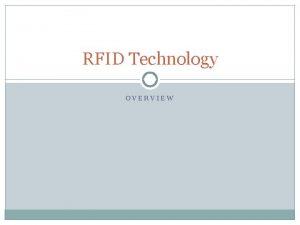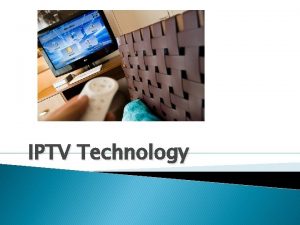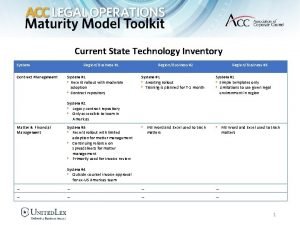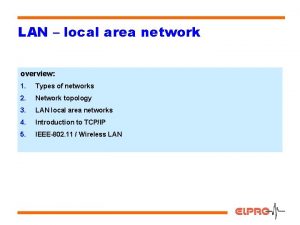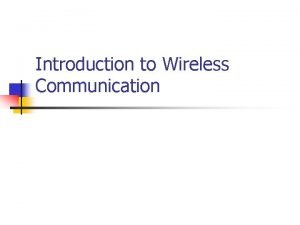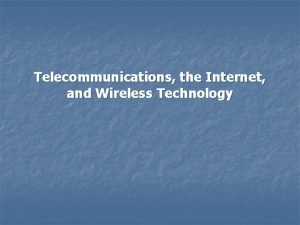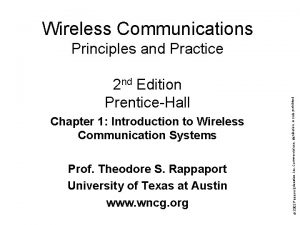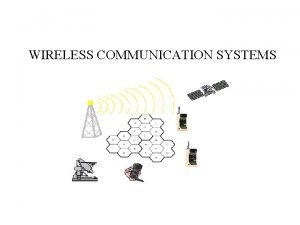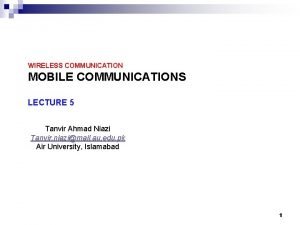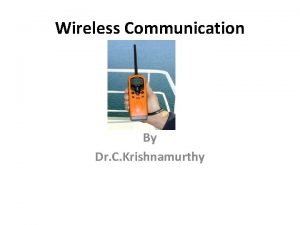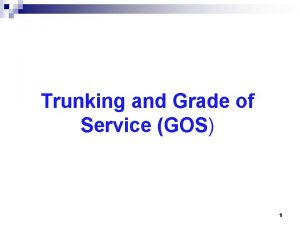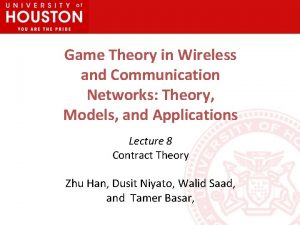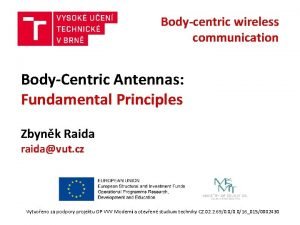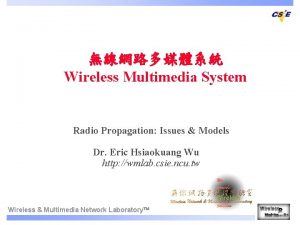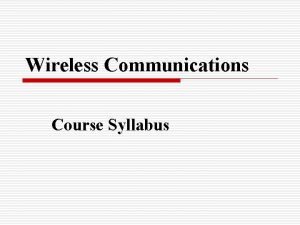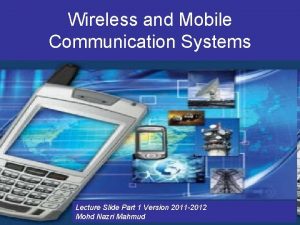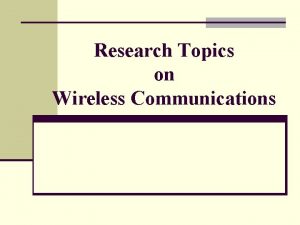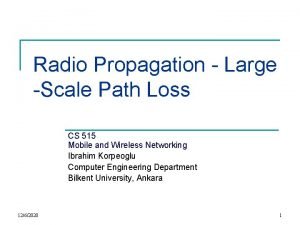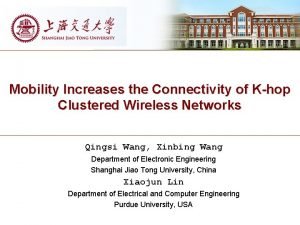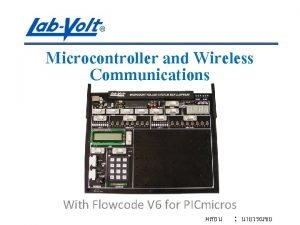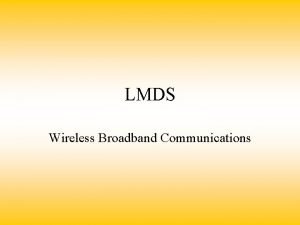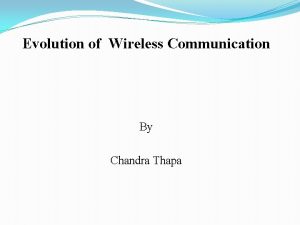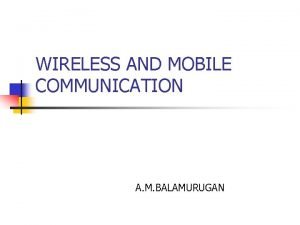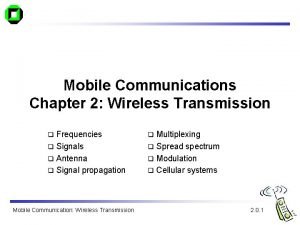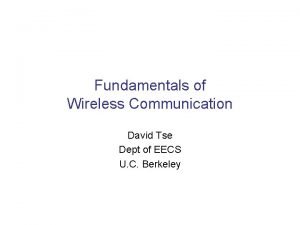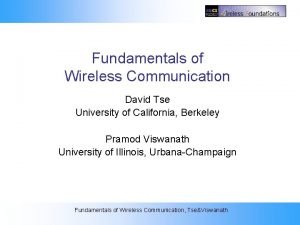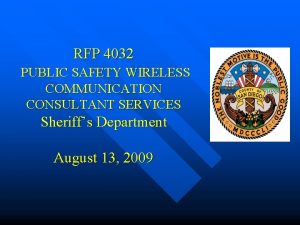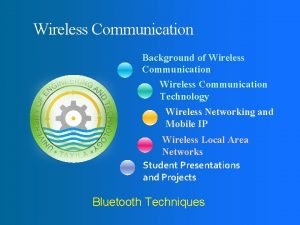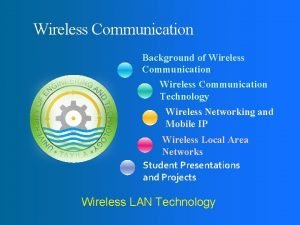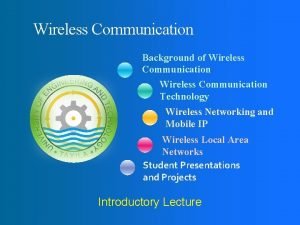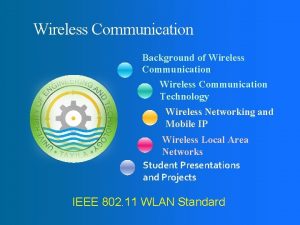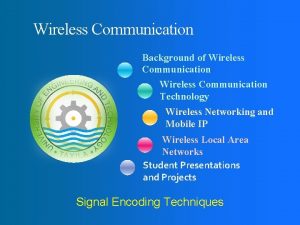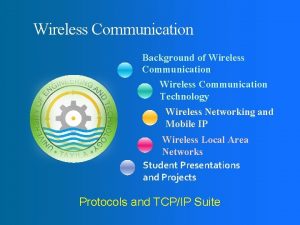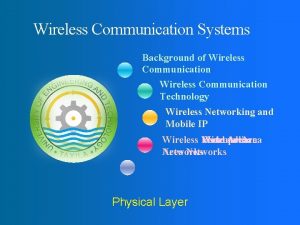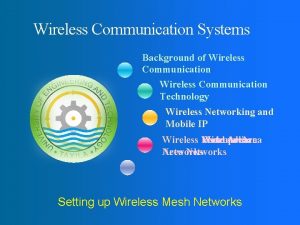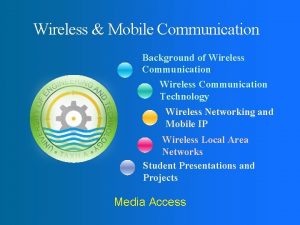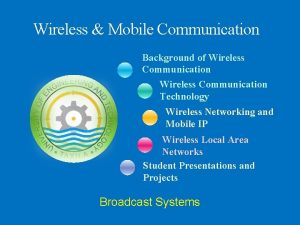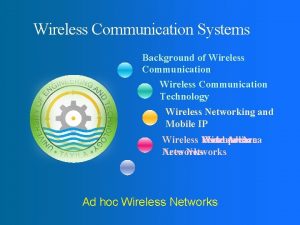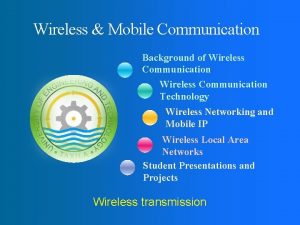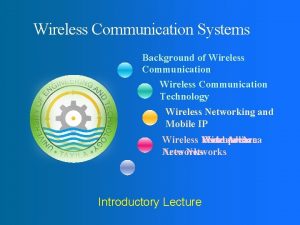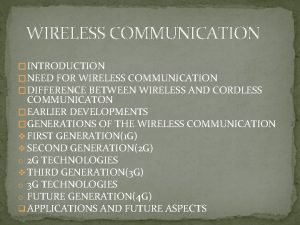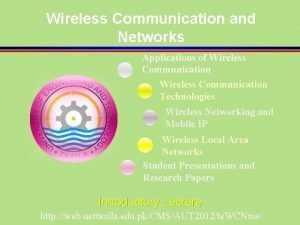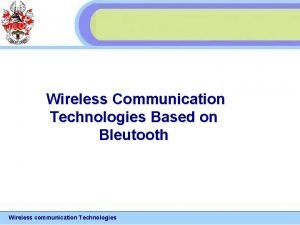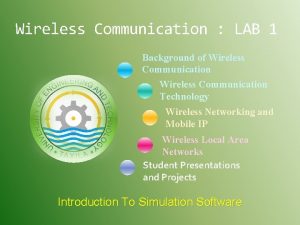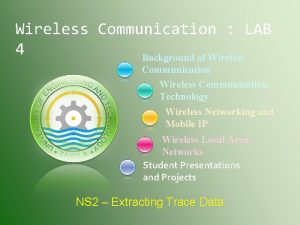Wireless Communication Technology Chapter 1 Overview of Wireless



































- Slides: 35

Wireless Communication Technology Chapter 1 Overview of Wireless Communications Asst. Prof. Bijaya Shrestha Department of Electronics & Communication Engineering nec

Evolution of Mobile Radio Communications (I) �Improvements in digital signal processing (DSP), digital modulation techniques, RF (radio frequency) technology, large-scale circuit integration, and miniaturization techniques have contributed for the evolution of today’s mobile radio communications. �In 1946, the first public mobile telephone service was introduced in the U. S. �Each system used a single, high-powered transmitter and larger tower in order to cover distances over 50 km. �It was based on FM (frequency modulation) and push-to-talk system. �It needed 120 k. Hz of channel bandwidth in a half-duplex mode. �It required operator for switching purpose. By Asst. Prof. Bijaya Shrestha, nec, 2015 2

Evolution of Mobile Radio Communications (II) �In 1950, the FCC (Federal Communications Commission) doubled the number of mobile telephone channels by reducing the channel bandwidth to 60 k. Hz. �In the 1950 s and 1960 s, IMTS (Improved Mobile Telephone Service) was developed with full-duplex and direct-dialing functionalities. Channel bandwidth was again halved to 30 k. Hz thereby increasing the number of channels. �During the 1950 s and 1960 s, AT & T Bell Laboratories and other telecommunications companies throughout the world developed theory and techniques of cellular radiotelephony. By Asst. Prof. Bijaya Shrestha, nec, 2015 3

Evolution of Mobile Radio Communications (III) �The world’s first cellular system was implemented by the NTT (Nippon Telephone and Telegraph) company in Japan and deployed in 1979. �In Europe, the Nordic Mobile Telephone system (NMT 450) was developed in 1981. �The AMPS (Advanced Mobile Phone System) was the first U. S. cellular telephone system deployed in 1983. �The European Total Accesss Cellular System (ETACS) was deployed in 1985 which is virtually identical to the U. S. AMPS system. �In Germany, a cellular standard called C-450 was introduced in 1985. By Asst. Prof. Bijaya Shrestha, nec, 2015 4

Evolution of Mobile Radio Communications (IV) �The first generation European cellular systems are generally incompatible with one another because of the different frequencies and communication protocols used. �The first generation European cellular systems are now being repaced by the European digital cellular standard GSM (Global System for Mobile) which was first deployed in 1990. �The GSM standard is the first universal digital cellular system accepted worldwide. � In 1991, the first U. S. Digital Cellular (USDC) standard services (Electronic Industry Association Interim Standard IS-54 and later IS-136) were introduced. By Asst. Prof. Bijaya Shrestha, nec, 2015 5

Evolution of Mobile Radio Communications (V) �Qualcomm developed the first cellular system based on code division multiple access (CDMA) in 1993 in U. S. The Telecommunications Industry Association (TIA) standardized Qualcomm’s system as IS-95. �In Japan, the Pacific Digital Cellular (PDC) standard deployed in 1993, provides digital cellular coverage using a system similar to North America’s USDC. By Asst. Prof. Bijaya Shrestha, nec, 2015 6

Wireless Communications System Definitions (I) �Base Station (BS): A fixed station in a mobile radio system used for radio communication with mobile stations. �Mobile Station (MS): A station in the cellular radio service intended for use while in motion at unspecified locations. �Mobile Switching Center (MSC): MSC is the switching center which coordinates the routing of calls in a large service area. In a cellular radio system, the MSC connects the cellular base stations and the mobiles to the PSTN. An MSC is also called a mobile telephone swtiching office (MTSO) By Asst. Prof. Bijaya Shrestha, nec, 2015 7

Wireless Communications System Definitions (II) �Forward Channel: Radio channel used for transmission of information from the base station to the mobile. �Reverse Channel: Radio channel used for transmission of information from the mobile to the base station. �Control Channel: Radio channel used for transmission of call setup, call request, call initiation, and other control purposes. �Page: A brief message which is broadcast over the entire service area, usually in a simulcast fashion by many base stations at the same time. By Asst. Prof. Bijaya Shrestha, nec, 2015 8

Wireless Communications System Definitions (III) �Handoff: The process of transferring a mobile station from one channel or base station to another. �Roamer: A mobile station which operates in a service area other than that from which service has been subscribed. �Subscriber: A user who pays subscription charges for using a mobile communication system. �Transceiver: A device capable of simultaneously transmitting and receiving radio signals. By Asst. Prof. Bijaya Shrestha, nec, 2015 9

Evolution of Cellular Mobile Radio Communications (I) � First Generation (1 G) Cellular Networks � Are based on FDMA/FDD and analog FM technologies. � Include AMPS, ETACS, and NTT systems. � Were deployed in 1980 s. � Were developed mainly for voice communication. � Second Generation (2 G) Cellular Networks � Are based on digital modulation formats and TDMA/FDD and CDMA/FDD multiple acess techniques. � Include GSM, IS-136, PDC, IS-95 etc. � Were deployed in 1990 s. � Focuss on high capacity to replace 1 G systems. � Use circuit-switched networks that limit data throughput rate up to 10 kilobits per second, which is too slow for rapid email and Internet brwosing applications. � Short messaging system (SMS) is a popular feature of GSM. By Asst. Prof. Bijaya Shrestha, nec, 2015 10

Evolution of Cellular Mobile Radio Communications (II) �GSM � Is based on TDMA standard � Supports eight time slotted users for each 200 k. Hz radio channel � Has been deployed widely in Europe, Australia, South America, and some parts of the U. S. �IS-136 � Is based on TDMA standard. � Is also known as North American Digital Cellular (NADC) � Supports three time slotted users for each 30 k. Hz radio channel. � Is popular in North America, South America, and Australia. By Asst. Prof. Bijaya Shrestha, nec, 2015 11

Evolution of Cellular Mobile Radio Communications (III) �PDC � Is based on TDMA standard. � Is similar to IS-136. �IS-95 � Is based on CDMA. � Is also known as cdma. One. � Supports up to 64 users that are orthogonally coded and simultaneously transmitted on each 1. 25 MHz channel. � Is widely deployed in North America, Korea, Japan, China, South America, and Australia. By Asst. Prof. Bijaya Shrestha, nec, 2015 12

Evolution of Cellular Mobile Radio Communications (IV) By Asst. Prof. Bijaya Shrestha, nec, 2015 13

Evolution of Cellular Mobile Radio Communications (V) � 2. 5 G Cellular Networks �Are based on data-centric standards. �Use of upgraded 2 G equipment and softwares to support higher data rate transmissions for fast Internet. �HSCSD (High Speed Circuit Switched Data) � Is a circuit switched technique that allows a single mobile subscriber to use consecutive time slots in the GSM standard. � Is able to provide a transmission rate of up to 57. 6 kbps to individual users by using four consecutive time slots. By Asst. Prof. Bijaya Shrestha, nec, 2015 14

Evolution of Cellular Mobile Radio Communications (VI) �GPRS (General Packet Radio Service) � Is a packet-based data network suitable for non-real time Internet usage. � Supports multi-user network sharing of individual radio channels and time slots. � Can support many more users than HSCSD. � Subscriber units are automatically instructed to tune to dedicated GPRS radio channels and particular time slots for “always on” access to the network. � Dedicated subsciber is able to achieve as much as 171. 2 kbps when provided all eight time slots of a GSM radio channel. By Asst. Prof. Bijaya Shrestha, nec, 2015 15

Evolution of Cellular Mobile Radio Communications (VII) �EDGE (Enhanced Data rates for GSM Evolution) � Is a more advanced upgrade to the GSM standard. � Introduction of 8 -PSK � Allows multiple modulation and coding schemes (MCS) � Use of GMSK for low data rate and use of 8 -PSK for high data rate � Is sometimes referred to as Enhanced GPRS or EGPRS. � Normally provides data rate of about 384 kbps per single GSM channel. � Can provide several Mbps of data throughput using multicarrier transmissions. By Asst. Prof. Bijaya Shrestha, nec, 2015 16

Evolution of Cellular Mobile Radio Communications (VIII) �IS-95 B � Provides high speed packet and circuit switched data access on a common CDMA radio channel by dedicating multiple orthogonal user channels for specific users and specific purposes. � Allows a dedicated user to use eight different user Walsh codes simultaneously and in parallel for an instantaneous throughput 64 kbps. By Asst. Prof. Bijaya Shrestha, nec, 2015 17

Evolution of Cellular Mobile Radio Communications (IX) �Third Generation (3 G) Wireless Networks �To provide multimedia services �International Telecommunications Union-Radio Communication Sector (ITU-R) has formulated a plan IMT 2000 (International Mobile Telephone -2000) to make a single, ubiquitous wireless communications standard for all countries throughout the world. However, the standards were divided into GSM/IS-136/PDC and CDMA (IS-95) in 2 G. �The 3 G evolution for GSM, IS-136, and PDC systems leads to wideband CDMA (W-CDMA), also called UMTS (Universal Mobile Telecommunications Service). �The 3 G evolution for CDMA systems leads to cdma 2000. By Asst. Prof. Bijaya Shrestha, nec, 2015 18

Evolution of Cellular Mobile Radio Communications (X) �ITU IMT-2000 standards organizations are separated into � 3 GPP (3 G Partnership Project) for W-CDMA standards based on backward compatibility with GSM and IS 136/PDC and � 3 GPP 2 (3 G Partnership Project) for cdma 2000 standards based on backward compatibility with IS-95. By Asst. Prof. Bijaya Shrestha, nec, 2015 19

Evolution of Cellular Mobile Radio Communications (XI) �W-CDMA (UMTS) �Evolved under European Telecommunications Standards Institute (ETSI). �It is packet-based wireless service designed for high data rate. �It supports data rates up to 2. 048 Mbps per user (if the user is stationary) thereby allowing high quality, multimedia, streaming audio, streaming video, and broadcast-type services to consumers. By Asst. Prof. Bijaya Shrestha, nec, 2015 20

Evolution of Cellular Mobile Radio Communications (XII) �cdma 2000 was developed under Telecommunications Industry Association (TIA) of the U. S. �Cdma 2000 1×RTT (Radio Transmission Technology) uses a single 1. 25 MHz radio channel. It supports data rate of up to 144 kbps per user. �cdma 2000 1×EV provides CDMA carriers with the option of data only (cdma 2000 1×EV-DO) or with data and voice (cdma 2000 1×EV-DV). By Asst. Prof. Bijaya Shrestha, nec, 2015 21

Evolution of Cellular Mobile Radio Communications (XIII) �The cdma 2000 1×EV-DO option dedicates the radio channel strictly to data users, and supports greater than 2. 4 Mbps throughput per user on a particular CDMA channel. �cdma 2000 1×EV-DV supports both voice and data users, and can offer usable data rates up to 144 kbps. �The cdma 2000 3×RTT standard uses three adjacent 1. 25 MHz radio channels that are used together to provide packet data throughput speeds in excess of 2 Mbps. � The cdma 2000 3× has a very similar user data rate throughput when compared to W-CDMA. By Asst. Prof. Bijaya Shrestha, nec, 2015 22

Simplex and Duplex Communication �Simplex Communication Systems �In simplex systems, communication is possible in only one direction. �E. g. , paging system. �Duplex Communication System �Half-Duplex Systems: allow two-way communication but in one direction at a time. E. g. , walkie-talkie. �Full-Duplex Systems: allow two-way communication in both directions simultaneously. E. g. , telephone. By Asst. Prof. Bijaya Shrestha, nec, 2015 23

Duplex Communication: FDD & TDD (I) �FDD (Frequency Division Duplex): �Forward channel and reverse channel use different frequency bands. �The transmit and receive frequencies are normally separeted by about 5 % of the nominal RF frequency. �FDD is used exclusively in analog mobile radio systems. By Asst. Prof. Bijaya Shrestha, nec, 2015 24

Duplex Communicaiton: FDD & TDD (II) �TDD (Time Division Duplex): �A single frequency channel is used. The channel is divided into time slots. Mobile station and base station transmits on the time slots alternately. �TDD is only possible with digital transmission formats and digital modulation, and is very sensitive to timing. �TDD is used only for small area wireless applications. By Asst. Prof. Bijaya Shrestha, nec, 2015 25

Radio Spectrum By Asst. Prof. Bijaya Shrestha, nec, 2015 26

Conventional Mobile Radio vs. Cellular Mobile Radio �In conventional mobile radio communication, a single powerful transmitter is located at the highest spot to cover the largest service area up to 50 kilometers of radius. �In cellular mobile radio communication, a service area is divided into many smaller areas (also called cells) and each cell is served by its own low-power transmitter. �By doing this, the same frequency can be used in several cells thereby increasing the capacity. By Asst. Prof. Bijaya Shrestha, nec, 2015 27

Cellular Mobile vs. Wireless Local Loop (WLL) (I) �Cellular Mobile �Is intended to provide communication for people on the move. �Must have global coverage. By Asst. Prof. Bijaya Shrestha, nec, 2015 28

Cellular Mobile vs. Wireless Local Loop (WLL) (II) By Asst. Prof. Bijaya Shrestha, nec, 2015 29

Cellular Mobile vs. Wireless Local Loop (WLL) (III) �Wireless Local Loop (WLL) �WLL can be also termed as Fixed Wireless Access (FWA). �Base station has an antenna at the top of a tower or building. �Subscribers have a fixed antenna that has a line-of-sight to the base station antenna. �The base station is linked to a switching center wired or wirelessly. �The switching center is connected to local telephone lines or other telephone networks. �An Internet Service Provider (ISP) may be connected to the switch. �WLL is used at frequencies greater than 10 GHz. By Asst. Prof. Bijaya Shrestha, nec, 2015 30

Features of Cellular Mobile Radio �Frequency Reuse: This concept increases the capacity of the mobile communication system. �Directional Antennas: are used for good reception of signal. �Broadcast Messages and Paging: to transfer the same information to all the mobile users of all the base stations. �Handoff: is used for uninterrupted service while going from one cell to another cell. By Asst. Prof. Bijaya Shrestha, nec, 2015 31

Digital Cellular Radio �Digital cellular radio technology was developed to allow more customers to be served by a reduced number of towers and to allow the addition of advanced features. It provides security too. �It uses different access technologies: FDMA, TDMA, CDMA, and SDMA (Space Division Multiple Access). �It uses digital modulation technique such as PSK (Phase Shift Keying). �It incorporates digital signal processing technologies including voice digitization, speech compression, control and data channel coding etc. By Asst. Prof. Bijaya Shrestha, nec, 2015 32

Point-to-Multipoint (PMP) System (I) �PMP communication is the one that establishes communication from one point to many other points simultaneously. �PMP systems include cellular and WLL systems. �A PMP network topology consists of a central base station (BS) that supports multiple subscriber stations (SS), providing network access from one location to many. �In the down-link direction, the base station broadcasts the signal to all the remote terminals within its serving cell. �In the up-link direction, a “multiple access” method is required for the transmission from remote terminals to avoid interference. By Asst. Prof. Bijaya Shrestha, nec, 2015 33

Point-to-Multipoint (PMP) System (II) By Asst. Prof. Bijaya Shrestha, nec, 2015 34

References Theodore S. Rappaport, Wireless Communications, second edition, Prentice Hall, 2012. 2. Digital Cellular Technology, http: //www. globalspec. com/reference/52291/203279 /chapter-3 -digital-cellular-radio-technology [2015/09/27] 3. Point-to-Multipoint Topology, http: //itlaw. wikia. com/wiki/Point-tomultipoint_topology [2015/09/27] 1. By Asst. Prof. Bijaya Shrestha, nec, 2015 35
 Telecommunications the internet and wireless technology
Telecommunications the internet and wireless technology Rfid technology overview
Rfid technology overview Iptv technology overview
Iptv technology overview An overview of data warehousing and olap technology
An overview of data warehousing and olap technology An overview of data warehousing and olap technology
An overview of data warehousing and olap technology Overview of the current state of technology
Overview of the current state of technology Lan type a
Lan type a History of wireless technology
History of wireless technology Telecommunications, the internet, and wireless technology
Telecommunications, the internet, and wireless technology Wireless communication introduction
Wireless communication introduction Mobile communication
Mobile communication Co channel interference
Co channel interference Advantages of wireless transmission
Advantages of wireless transmission Grade of service
Grade of service Next generation wireless communication market
Next generation wireless communication market Game theory in wireless and communication networks
Game theory in wireless and communication networks Dr ian goldsmith
Dr ian goldsmith Cdpd in wireless communication
Cdpd in wireless communication Fundamental principles of wireless communication
Fundamental principles of wireless communication Free space propagation model in wireless communication
Free space propagation model in wireless communication Wireless communication course syllabus
Wireless communication course syllabus Large scale fading in wireless communication
Large scale fading in wireless communication Wireless communication research topics
Wireless communication research topics Friis free space propagation model
Friis free space propagation model Free space propagation model in wireless communication
Free space propagation model in wireless communication Microcontroller wireless communication
Microcontroller wireless communication Lmds in wireless communication
Lmds in wireless communication Evolution of wireless communication
Evolution of wireless communication Mobile and wireless communication syllabus
Mobile and wireless communication syllabus Wireless communication
Wireless communication Fundamentals of wireless communications
Fundamentals of wireless communications Fundamental of wireless communication
Fundamental of wireless communication Trunking efficiency in wireless communication
Trunking efficiency in wireless communication Wireless communication consultant
Wireless communication consultant Chapter 24 trauma overview
Chapter 24 trauma overview Chapter 14 medical overview
Chapter 14 medical overview

